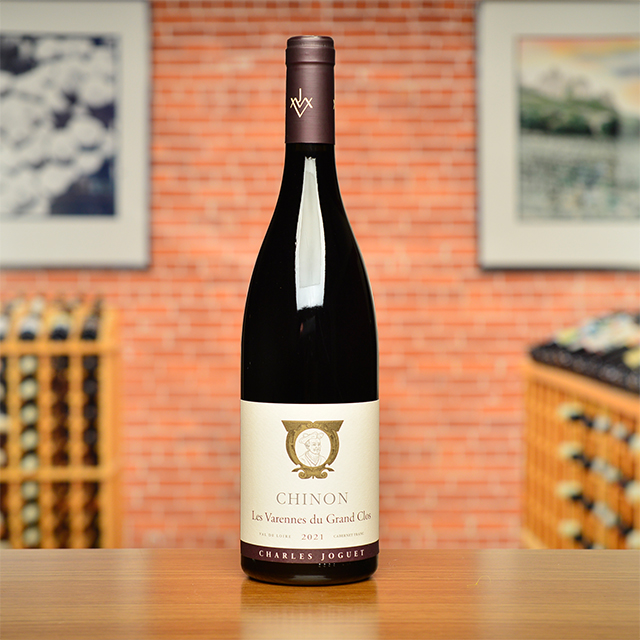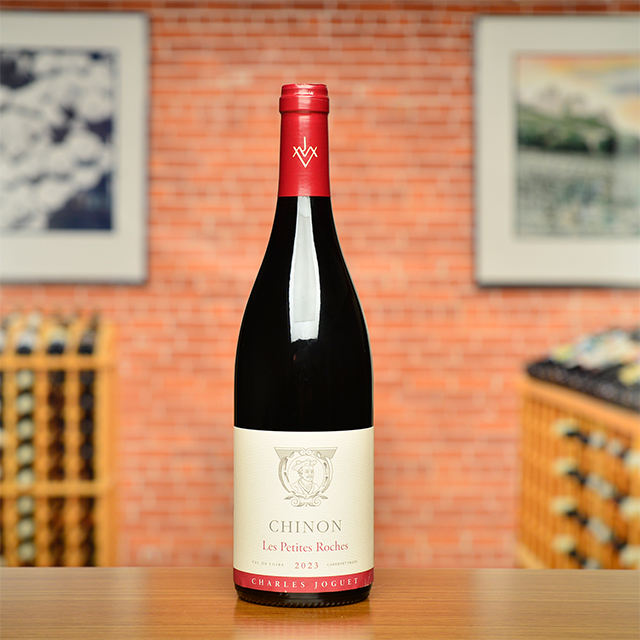Notify me
2017 Chinon “Clos de la Dioterie”
Charles Joguet
A wine of serious density from north-facing vines planted in the 1930s, only starting to express its full potential. It provides savory sensations highlighted by licorice, mint, and spice, culminating in a majestic tannin. Highly recommended for the cellar, as old vintages of La Dioterie are nothing short of epic.
—Anthony Lynch
| Wine Type: | red |
| Vintage: | 2017 |
| Bottle Size: | 750mL |
| Blend: | Cabernet Franc |
| Appellation: | Chinon |
| Country: | France |
| Region: | Loire |
| Producer: | Charles Joguet |
| Winemaker: | Kevin Fontaine |
| Vineyard: | Planted in 1930 to 1940, 2.22 ha |
| Soil: | White Limestone, Clay |
| Aging: | Prolonged aging in 1-3 year-old barrels for 12-15 months |
| Farming: | Organic (certified) |
| Alcohol: | 13.5% |
More from this Producer or Region

2016 Chinon “Les Varennes du Grand Clos” MAGNUM
France | Loire
Joguet’s Varennes du Grand Clos has fine-grained tannins that seem to melt into the richness of a marbled steak in an almost magical way.

2021 Chinon “Clos de la Dioterie”
France | Loire
Age-worthy red from one of Chinon’s top sites, by a storied domaine.

Chotard’s Best-In-Class Sancerres
France | Loire
These 2023s will take you on a journey several decades back to the old days of Sancerre.

2021 Chinon “Les Varennes du Grand Clos”
France | Loire
With floral aromas and fine-grained tannins, it already showcases its charms.

2020 Chinon “Les Varennes du Grand Clos”
France | Loire
With floral aromas and fine-grained tannins, it already showcases its charms.

2018 Saumur Blanc “L’Échelier”
France | Loire
Burgundian-like in character from its time spent in barrel, the laser-like acidity will become even more enticing with some age.

2020 Chinon “Clos du Chêne Vert”
France | Loire
Chinons from Joguet are known for their firm minerality, but this one is quite charming as well, with plummy black fruit, myrtle, and notes of warm licorice.

2024 Cheverny
France | Loire
Sauvignon and a splash of Chardonnay: the epitome of minerally Loire refreshment

2023 Chinon “Les Petites Roches”
France | Loire
Showing off Cabernet in its most delicate, charming form, rife with aromas of roses, damp earth, and little red berries.

2022 Chinon “Cuvée Terroir”
France | Loire
The perfect combination of tart red fruit, herbaceousness, and graphite earthiness.
About The Producer
Charles Joguet
About The Region
Loire

The defining feature of the Loire Valley, not surprisingly, is the Loire River. As the longest river in France, spanning more than 600 miles, this river connects seemingly disparate wine regions. Why else would Sancerre, with its Kimmeridgian limestone terroir be connected to Muscadet, an appellation that is 250 miles away?
Secondary in relevance to the historical, climatic, environmental, and cultural importance of the river are the wines and châteaux of the Jardin de la France. The kings and nobility of France built many hundreds of châteaux in the Loire but wine preceded the arrival of the noblesse and has since out-lived them as well.
Diversity abounds in the Loire. The aforementioned Kimmeridgian limestone of Sancerre is also found in Chablis. Chinon, Bourgueil, and Saumur boast the presence of tuffeau, a type of limestone unique to the Loire that has a yellowish tinge and a chalky texture. Savennières has schist, while Muscadet has volcanic, granite, and serpentinite based soils. In addition to geologic diversity, many, grape varieties are grown there too: Cabernet Franc, Chenin Blanc, Sauvignon Blanc, and Melon de Bourgogne are most prevalent, but (to name a few) Pinot Gris, Grolleau, Pinot Noir, Pineau d’Aunis, and Folle Blanche are also planted. These myriad of viticultural influences leads to the high quality production of every type of wine: red, white, rosé, sparkling, and dessert.
Like the Rhône and Provence, some of Kermit’s first imports came from the Loire, most notably the wines of Charles Joguet and Château d’Epiré—two producers who are featured in Kermit’s book Adventures on the Wine Route and with whom we still work today.
More from Loire or France
2017 Jasnières “Chant de Vigne”
Christine de Mianville France | Loire
2024 Vin de France Rosé Brut “Elle est pas bulle la vie?”
Catherine & Pierre Breton France | Loire
2024 Val de Loire Sauvignon Blanc “Unique”
Domaine du Salvard France | Loire
2024 Menetou-Salon Blanc “Le Prieuré”
Prieuré de Saint Céols France | Loire
2021 Saumur Blanc “Terres”
Thierry Germain France | Loire
2024 Coteaux du Loir Blanc
Pascal Janvier France | Loire
2021 Chinon “Les Varennes du Grand Clos”
Charles Joguet France | Loire
2023 Vouvray “Pierres Rousses”
Catherine & Pierre Breton France | Loire
2023 Sancerre “Racines”
Daniel Chotard France | Loire
2020 Vin de France Blanche
Domaine Michel Brégeon France | Loire
2020 Saumur Blanc “Clos Romans”
Thierry Germain France | Loire
2020 Saumur Champigny “Outre Terre”
Thierry Germain France | Loire
2017 Jasnières “Chant de Vigne”
Christine de Mianville France | Loire
2024 Vin de France Rosé Brut “Elle est pas bulle la vie?”
Catherine & Pierre Breton France | Loire
2024 Val de Loire Sauvignon Blanc “Unique”
Domaine du Salvard France | Loire
2024 Menetou-Salon Blanc “Le Prieuré”
Prieuré de Saint Céols France | Loire
2021 Saumur Blanc “Terres”
Thierry Germain France | Loire
2024 Coteaux du Loir Blanc
Pascal Janvier France | Loire
2021 Chinon “Les Varennes du Grand Clos”
Charles Joguet France | Loire
2023 Vouvray “Pierres Rousses”
Catherine & Pierre Breton France | Loire
2023 Sancerre “Racines”
Daniel Chotard France | Loire
2020 Vin de France Blanche
Domaine Michel Brégeon France | Loire
2020 Saumur Blanc “Clos Romans”
Thierry Germain France | Loire
2020 Saumur Champigny “Outre Terre”
Thierry Germain France | Loire
Kermit once said...

Kermit once said...
Living wines have ups and downs just as people do, periods of glory and dog days, too. If wine did not remind me of real life, I would not care about it so much.

















